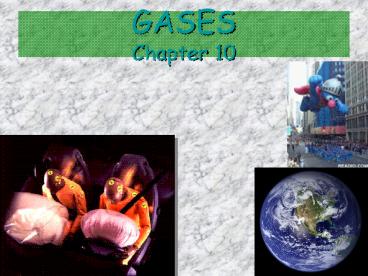GASES Chapter 10 - PowerPoint PPT Presentation
1 / 26
Title:
GASES Chapter 10
Description:
GASES Chapter 10 Properties ... Force (N) Pascal = 1x105 N/m2 ... The hypothetical gas has mass, but no volume, and does not condense into a liquid or solid ... – PowerPoint PPT presentation
Number of Views:275
Avg rating:3.0/5.0
Title: GASES Chapter 10
1
GASESChapter 10
2
Barometric Pressure
Barometric Pressure
3
Gravity pulls the air molecules toward the earth,
giving them weight. The weight of the air
molecules all around us is called the air
pressure.
4
Like all matter, air molecules have mass.
5
Air pressure is equal in all directions.
Pressure force per unit area
6
Air molecules are everywhere.
7
Properties of Gases Gas Pressure
Air column 1m x 1m
- A. Gas Pressure
Pascal 1x105 N/m2
Pressure 1x103 kPa
8
Low altitudes higher pressure
9
Barometric Pressure
Standard Atmospheric Pressure 1.00 atm 760 mm
Hg, 760 torr 101.325 kPa 1.01325 bar 1013.25
mbar 14.7 psi 29.92 ins/Hg
10
Introducing...
The Aneroid Barometer!!
- No fragile tubes!
- No toxic chemicals!
- No batteries!
- Never needs winding!
Get yours today!!
11
Aneroid Barometer
- relies on evacuated, collapsible chamber
- atmospheric weight compresses chamber
- initially calibrated to local altitude,
- temperature and latitude
12
An aneroid barometer uses a cell which has had
most of the air removed.
As the air pressure around the cell increases, it
presses on the cell, which causes the needle to
move.
Television weather forecasters usually give
barometric pressure in inches of mercury.
However, meteorologists measure atmospheric
pressure in millibars.
13
Measurement of Pressure
- barometer weight meter
- Mercury barometer developed by Torricelli
- Aneroid barometer uses no liquid
- 3 corrections required
- Elevation
- Temperature
- Gravity changes with latitude
14
The standard atmosphere is defined as the
pressure exerted by a mercury column of exactly
760 mm in height when the density equals 13.6
g/mL.
15
And now, we pause for this commercial message
from STP
OK, so its really not THIS kind of STP STP in
chemistry stands for Standard Temperature and
Pressure
Standard Pressure 1 atm or equivalent Standard
Temperature 0? C or 273 K
STP allows us to compare amounts of gases between
different pressures and temperatures
16
Manometers
17
B. Simple Gas Laws
Temp constant
- Boyle 1662
INVERSE RELATIONSHIP
18
- pressure decreases non-linearly
- pressure will be less at P2 than at P1
- due to pressure decreasing with
- height
- pressure differences responsible for
- movement of air
- recording stations are reduced to sea
- level pressure equivalents
19
Boyles Law
- Pressure and Volume are INVERSELY PROPORTIONAL
if moles and temperature are constant (do not
change). - For example, P goes up as V goes down.
- P1V1 P2 V2
Robert Boyle (1627-1691). Son of Early of Cork,
Ireland.
20
Charless Law
To convert Celsius to Kelvin T(K) T(C)
273.15
V ? T
Pressure constant
DIRECT RELATIONSHIP
21
Charless Law
- If moles and pressure are constant then
- V and T are directly proportional.
- V1 V2
- T1 T2
- If one temperature goes up, the volume goes up!
Jacques Charles (1746-1823). Isolated boron and
studied gases. Balloonist.
22
Gay-Lussacs Law
- If moles and Volume are constant, then
- P and T are directly proportional.
- P1 P2
- T1 T2
- If one temperature goes up, the pressure goes up!
Joseph Louis Gay-Lussac (1778-1850)
23
Avogadros Hypothesis
- Equal volumes of gases at constant T and P have
the same number of molecules. - V and moles are directly related
V1 V2 n1 n2
24
- Molecular movement in a sealed container
- pressure increased by increasing density (b)
- or temperature (c)
25
Combined Gas Law
P1
V1
P2
Boyles Law Charles Law Gay-Lussacs Law
V2
T1
T2
26
Importance of Gases
- Airbags fill with N2 gas in an accident.
- Gas is generated by the decomposition of sodium
azide, NaN3. - 2 NaN3 ---gt 2 Na 3 N2































